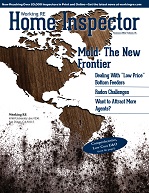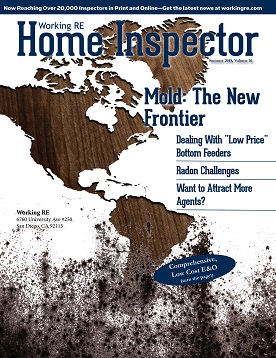 |
> E&O/GL Insurance for Home Inspectors Competitive Rates, Broad Coverage, Free Risk Management, online inspection support for tough questions, discounts on education and more… Professional Coverage, Competitive Pricing Shop OREP today! |
Tips to Conserve Water (and the Cost of a Leak)
by Ron Passaro, ASHI Member 0000001
Water is the ever present, yet frequently overlooked component of all living things on the planet earth—the liquid is formed when two gases, hydrogen and oxygen combine in the correct formula (H20). Life as we know it on earth began with the advent of that combination and throughout the early stages of evolution; all living things were contained within it.
Water provides us with many things: a surface upon which to travel and transport, sustenance for growing food, the most common drinking and cleaning fluid on the planet, to name a few. Indeed, approximately two-thirds of our bodies are made up of water—a person weighing 150 pounds is comprised of at least 100 pounds of water. Water, therefore, is an especially terrible thing to waste—without it we would not survive.
Cost of Leaks
One of the things I always explain to my clients is how leaks in household plumbing can cause a significant problem, although they may appear to be “only a drop at a time.” The average water loss calculated from a faucet that leaks at the rate of 30 drops per minute is 54 gallons per month! Fifty-four gallons of water is equivalent to more than two FULL bathtubs in an average home. At 60 drops per minute, it computes to 113 gallons each month, and at 120 drops per minute, equals a water loss of 237 gallons a month! Two hundred thirty- seven gallons is more than TEN average showers, by comparison. Attending to those leaky faucets is a relatively simple task and should you be one of those who pays a water bill, consider the savings you’ll make!
To give you an idea of just how costly a leaking faucet may be, consider the following: a drip 1/32″ (which is not a large drip) can result in the waste of 299 gallons in a 24-hour period. The Bridgeport Hydraulic Company computes the cost of that much water at about $95 each billing quarter. That means that a leak hardly larger than a period (.) in this article, and if allowed to run for a year, could result in an unnecessary expenditure of up to $400! In addition, if you live in a town that charges a sewer tax, this is usually calculated by your water consumption, an additional wasted expense.
The adverse effect of that much water on a septic system could be ruinous. A large volume of water constantly flowing through the septic system can flood the system and spoil the permeability of the soil, upon which it depends to function. The continuous flow of a volume of water through the system can cause premature system failure, running up a substantial and unnecessarily incurred expense.
(story continues below)
Another of the wasteful practices, brought about using modern conveniences, is the injudicious use of the flush toilet. Most common flush toilets can use as much as five gallons per flush —when it has been shown that considerably less water can be used to do the job of waste removal effectively. Water-saving toilets are now required by law in many states. They use three and a half gallons rather than five and perform the task of removal based on velocity instead of volume of water.
Showers can be made to use less water but be as effective as ever using “flow reducers.” They can conserve as much as 60 percent of the water used to take a typical shower, without diminishing the ability to make you clean. In addition to fixing leaky faucets, there are so many other ways to save water— which, although they may pose some minor inconveniences, will assure a longer-lasting resource.
Here are just a few water-saving tips that I share with homebuyers and home inspectors alike:
1. Scrape dishes, rather than rinsing, before putting them into the dishwasher.
2. Be sure to run FULL loads in both dishwasher and clothes washer. Avoid “small runs.”
3. Create a compost for vegetable waste rather than using the garbage disposal in the sink.
4. When washing the car, use a bucket to wash and run the hose only while rinsing.
5. Don’t allow water to “run” while brushing your teeth. Wet the brush, shut the water off while you brush, then rinse it when you’re done.
6. Don’t use running water to thaw frozen foods.
7. Don’t use lawn or garden sprinklers on hot, sunny or windy days. Much water is lost to evaporation.
8. Shut off nozzles on hoses when not actually using the flow, or better yet, use “pistol grip” nozzles which automatically shut off the flow.
9. Check your plumbing and faucets periodically for leaks, and attend to them as soon as possible. Homeowners can often fix the problems themselves—there are lots of good books on the subject, with straightforward directions.
10. At the very least, remember the old and wise advice for saving water: shower with a friend!
In summing up, pure water is becoming a more and more precious commodity. Leaks and drips don’t simply “go away;” they more often become worse and usually run twenty-four hours a day! That’s 8,760 hours a year—no amount of calculation can impress on us the importance of the volume of water that could be wasted in that amount of time.
Free Risk Management Online Course Claims and Complaints: How to Stay Out of Trouble
Available Now
Presenter: David Brauner, Senior Insurance Broker OREP
David Brauner, Senior Broker at OREP, shares insights and advice gained over 25+ years of providing E&O insurance for inspectors, showing you how to protect yourself and your business. Watch Now!
About the Author
Ronald J. Passaro is the President of RES-I-TEC, Inc. and the founder of ASHI. He has played a key role in organizing the inspection profession as we know it today. Passaro’s ASHI Member number is 0000001.
Note: The Summer 2019 issue of Working RE Inspector is mailing now to over 20,000 home inspectors nationwide. OREP Insureds enjoy guaranteed delivery of each print magazine and many more benefits.




by Ron Greene
Another tried and true water-saving technique is the classic Navy shower. Wet down, shut the water off, soap down, turn the water on, and rinse.
-